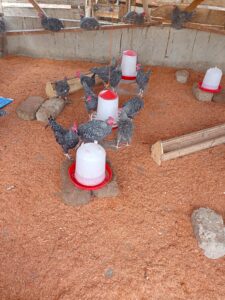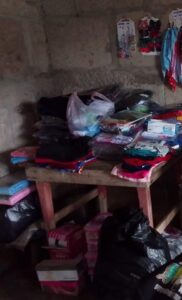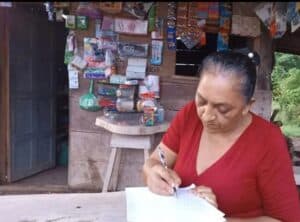
Increasing Yields and Improving Production

José Donoso Izaguirre Lago
José Donoso Izaguirre Lago grew up in a four-person household in the Mexico community in San Carlos, Rio San Juan, Nicaragua. His parents raised him to love working, and he grew to be a good person who serves as an example of his family. As an adult, Donoso moved 20 kilometers away to the La Zopilota community, where he worked as a farm manager, but three years ago he returned to Mexico where he works his father’s land, which he rents to farm. Donoso is open-minded and willing to change because he wants to learn new techniques every day to improve how he works his father’s land.
In 2020, Donoso became connected to local community leader Wilfredo Mejía, who was the community’s CAPS (Clean Water and Sanitation Committee) president. Mejia gave Donoso a pamphlet from Self-Help International about SHI’s double-row planting technique and about the quality protein maize (QPM) that SHI promotes, called INTA-Nutrader. The pamphlet piqued his curiosity, and he spoke briefly with a SHI staff person who explained SHI’s farming techniques to him. Donoso went to SHI to purchase INTA-Nutrader corn and then followed the pamphlet’s instructions, including those related to fertilization. Donoso had access to the recommended fertilizers – Urea at 46% and Completo 15-15-15 – so he used these.
Donoso recounts, “Once all the planting and fertilization activities were carried out using this variety of corn and the planting technique, I did not obtain the expected results, due to negative factors in the area including drought and pests (mice and zanates [a local bird]). As soon as the plants began emerging the pests caused serious damage and ruined much of the harvest. Then, there was a heavy rainstorm where I thought I would not harvest anything. But, these problems showed that the variety of maize was resistant to both drought and heavy rains. At harvest time, I went to the field and saw that there was lots of healthy corn, some corn that had peeled ends, and a few cobs in poor condition. Despite all the negative conditions, I obtained a yield of 20 quintales (2,000 pounds) shelled corn, which we used for both family consumption and to feed our farm animals. From this, I concluded that this maize has great characteristics that it works for us farmers in these rainy areas. It has a medium-sized cob and a solid grain of good weight. And, when the corn is consumed in the form of a tortilla, it has a different flavor. I have also observed that when I feed this corn to my farm animals they gain weight quickly, in a matter of months, and the flavor of the meat when consumed tastes better than when they have been fed with another type of corn or concentrate. From the moment of first consuming this corn, it’s the only one I’m willing to feed my family. I liked the planting technique practiced and I believe that this helps many people who do not have their own land to establish our plots of corn crops to make better use of the land.
“In 2021, I was part of a group of farmers who received training in the double row planting technique. The training was precise, concise and formal, and we learned how to do the planting, the times to apply fertilizer, and how and when to care for the maize to obtain even better results from it. I believe that the organization is doing a good job with farmers from different communities by teaching about this variety of corn and the planting techniques, and by providing in-kind financing (seed and inputs) to farmers to provide the best assistance.
“I was selected to obtain financing, and decided to plant 1 manzana of corn, which was a risk because the first time the pests only left me one half a manzana of corn. But, I knew the corn was high yielding and very resistant, so I again rented land and planted. But, I made the mistake of sowing in the dry season and the seed did not germinate. Two weeks passed without any rain, and then the heavy rains came. I checked the seed and it was germinating, but most of the seed died by drowning. Of the 80 rows I had planted in the manzana only 45 survived. But, of those 45 rows the ears were good sized and had excellent characteristics and from these I have obtained 40 quintales (4,000 pounds) of yield. In total, if there had been no problems at all I could have expected 80 quintales (8,000 pounds) from my manzana.
“I urge other farmers to carry out this technique, which is of great use for those of us who have low economic resources. This allows us to continue improving our production and for us to develop as farmers and pass new knowledge down to our offspring and have a better future for Nicaraguan families. I also recommend consuming varieties of corn rich in protein and minerals and encourage farmers to stop planting corn that is harmful to our health. I also urge farmers to put into practice all the knowledge acquired [from these trainings]. Let’s get ahead and leave traditional farming methods.
“I am grateful to the organization for being one of the few in the area that works hand-in-hand with farmers and provides us with new technologies to improve agriculture in our area. I wish the best for you and thank you for the support provided. We will continue working using the methods we’ve been taught [from SHI] and will share our new knowledge with neighbors to continue improving agriculture.”

 Previous Post
Previous Post Next Post
Next Post


